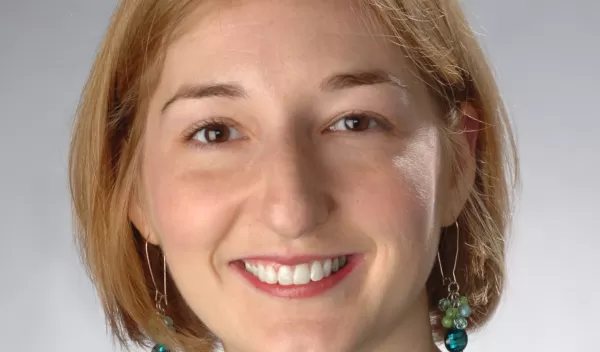
Materials, like metallic glass, can help us understand how cells break
"Disordered" materials are so-called because they are made up of objects that are in total disarray. Their composition, whether of atoms, molecules, grains or cells, do not lie in a neat, orderly pattern, but, instead, are all jumbled up.
"They're like sand on a beach, or mayonnaise," says M. Lisa Manning, an assistant professor of physics at Syracuse University. "When you mix up the oil and water for mayonnaise, the oil droplets sit unordered. That's what makes the mayonnaise stiff, all the little oil droplets packed together."
Many of these disordered materials, metallic glass, for example, are exceptionally strong, stronger than other metals, which offers potential for many industrial uses. But they also are prone to failure, and often break. Manning is studying these materials, searching for the defects in each that produce a crack-like fissure called a shear band.
"If we can find and identify these defects, then we can understand what causes the shear band," Manning says. "My goal is to figure out how they break. I am looking for defects in these materials. Once we figure out how they break, we can then figure out how to prevent them from breaking."
If successful, these materials--because of their inherent strength--could prove valuable in manufacturing, from constructing buildings to producing golf clubs, and "would be extremely good for making precision objects, because they don't change shape when they cool down," Manning says.
Insights from her research also could have important applications for biology, ultimately leading to possible future medical treatments, because disordered cells also exist in tissues, in developing embryos and in certain cancers.
"If you look at the cells in these tissues, they are disordered and look almost identical to pictures of foams, or emulsions," Manning says. "Embryos look like this, and so do healing wounds, and some cancer tissues too."
Biologists have a good understanding of what happens when a single cell migrates, or moves, she says. "But what is not well studied is how cells in this dense packing order move through tissues, which is important for wound healing," she says. "A cell has to push its way through its neighbors to move.
"If I can understand how non-biological particles move, this can provide new and exciting insights as to how a cell can move through tissues," she adds. "How stiff are the cells around it, for example? If I want a cell to move faster in tissue, should I make it softer or stiffer? The goal is to answer this, and test it."
Understanding this process could speed wound healing and "help repair embryonic defects when cells don't move to the correct places," she says.
In cancer, "recent work has shown that cancer cells are softer than other cells, and have different mechanical properties," she says. "One question I hope to answer: if a cancer cell is softer, does that make it easier to move through tissue and metastasize? If I could stiffen up that cell with a drug, maybe it wouldn't move anymore."
To find the defects, Manning creates computer simulations of the materials and studies sound modes that vibrate within the structure, much like a specific musical note vibrates inside an organ pipe. When the researchers find "localized" vibrations, that is, a mode where the structure vibrates a lot more in a certain place, "that's where the defect is located," she says.
Manning is conducting her research under an NSF Faculty Early Career Development (CAREER) award, which she received in 2014. The award supports junior faculty who exemplify the role of teacher-scholars through outstanding research, excellent education and the integration of education and research within the context of the mission of their organization.
As part of the grant's educational component, Manning plans to develop tutorials for high school juniors and seniors in Syracuse University's Project Advance, a program that enables these students to earn college physics credits. Project Advance provides instructional materials to high school teachers, and sponsors extra training sessions for them at the university. Manning is designing teaching modules about current research in materials science that can be directly integrated into the introductory physics curriculum, as well as an online math tutorial to tune up students' math skills.
"The goal is to increase diversity and retention in STEM disciplines," she says, referring to science, technology, engineering and mathematics. "We need more engineers, and we want to keep the ones we have, and recruit a more diverse body of students."
